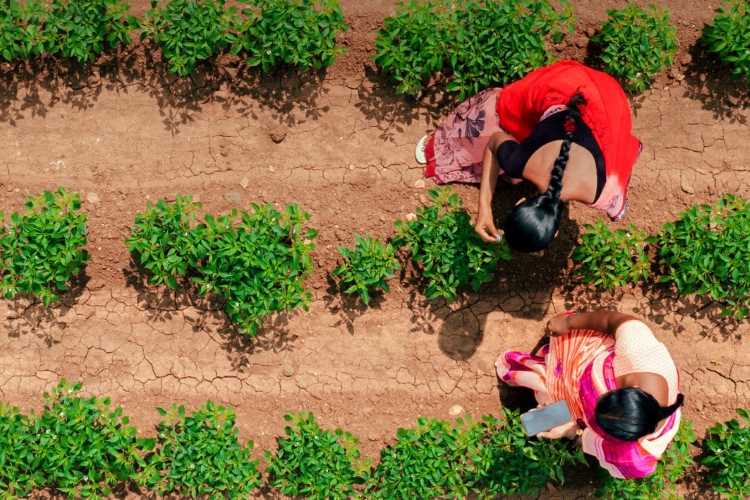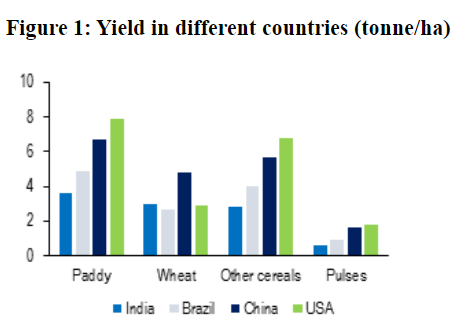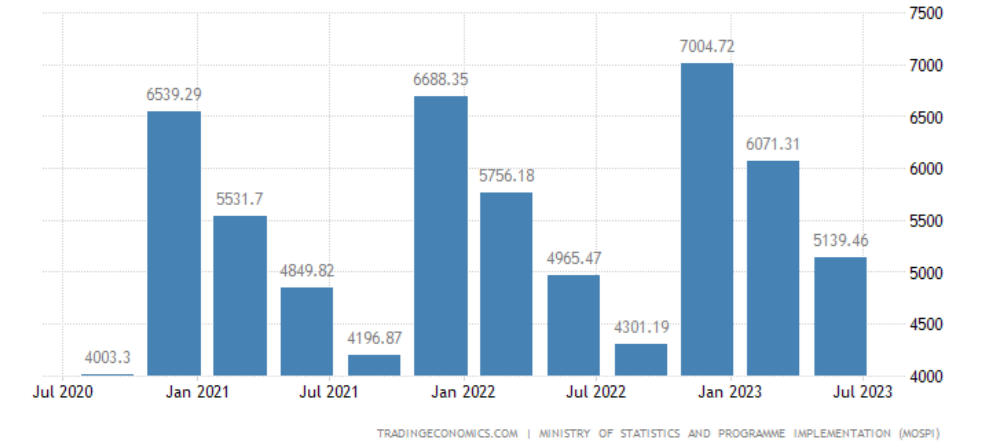
India has the world’s largest cropland area spanning 179.8 million hectares, more than the farm land available in the US and China. India has a large population of 1.41 billion, which provides a large and growing market for agricultural products. The country’s young population with a median age of 28 offers a large pool of potential labour available for the agriculture sector. Despite these advantages, India’s agricultural sector faces several challenges, including low productivity and high input costs. By addressing these challenges and leveraging its advantages in terms of population and arable land, India can become a global leader in agriculture.
In India, there is a tendency to blame the small landholdings of marginal farmers. For instance, those with less than two hectares of land make up 86% of landowners, possessing 47.3% of the land. Meanwhile, semi-medium and medium landowners who own 2-10 hectares account for 13.2%, owning 43.6% of the cropland. Compared with this, the average landholding in China is just 0.6 hectares, or 0.96 hectares.

India’s GDP from agriculture sector

Therefore, the claim that small size of holdings in India is making agriculture an unviable profession is unsubstantiated. The answer to India’s problems in farming lies in India’s low productivity figures compared with China’s. China’s agricultural output is valued at $1,367 billion, more than three times India’s $407 billion. For instance, wheat productivity in China is 5810 kg per hectare, compared with India’s 3500 kg per ha. In terms of growth rates for wheat and rice productivity, China’s figures stand at 3.75% and 5.21%, respectively, compared with India’s 2.44% and 2.96%.
READ I Success of urbanisation hinges on development-sustainability balance
Refocusing agriculture sector
Lately, there has been a focus on millets, coarse grains, and pulses. In India, their productivity is 1,591 kg and 699 kg, respectively, while in China, it is 5,470 kg and 1,533 kg. Both nations have a significant rural farming population, but due to effective policies, China’s productivity is thrice as much. Despite having the world’s highest arable land area, India faces challenges like forced migration, farmer suicides, and agriculture-driven poverty. The primary issues are low productivity and high input costs.
While India contemplates corporatisation to boost productivity, China’s success story revolves around small landholdings and a focus on cooperative farming. Interestingly, India’s fertilizer consumption surpasses China’s. The key to China’s high productivity lies in their scientific farming approaches, minimal water and fertilizer use, affordable input supplies, and structured marketing channels akin to India’s agricultural mandis. There is a pressing need for a holistic strategy that bridges the gap between agricultural universities, farmers, markets, and end-users.
Instead of focusing on corporatisation, India should prioritise cooperation, fostering farmer producer groups that can secure quality inputs at reasonable prices. Strengthening the Krishi Vigyan Kendras and encouraging more agriculture graduates is important. Other areas of emphasis should include improved irrigation, efficient fertilizer usage, farmer education, and soil management.
Factors like seeds, pesticides, fertilizers, crop types (like the shift of Punjab farmers from rice to alternative crops), and promoting millets for dry lands should be addressed. Horticulture practices, particularly with drip irrigation, can optimise water usage.
Another focus area of the policy should be investment in research and development. There is a need to develop new drought-resistant crops, pest and disease management techniques, and efficient water and fertilizer usage methods. Research can also help farmers to identify and adopt best practices that are tailored to their specific needs. Another important area is market linkages. Farmers need to have access to transparent and efficient markets for their produce to earn a fair price. The government can play a role in improving the infrastructure of agricultural mandis and developing more direct links between farmers and consumers.
In India, most farmers do to have access to affordable credit and insurance for managing risk and investing in new technologies. The government can play a role in providing these services, and in encouraging private sector participation. Also, there is a need for better infrastructure, such as roads, storage facilities, and irrigation systems, in rural areas. This will help to reduce post-harvest losses and improve farmers’ access to markets. The government also should develop adaptation strategies to help farmers cope with extreme weather events, such as droughts and floods, triggered by climate change.
A comprehensive agriculture policy should encompass Minimum Support Price (MSP) for all crops. The focus should be on cooperation, not corporatisation, which is backed by the examples of ITC and Dawat. It is vital to reinforce mandis for equitable transactions across agricultural, commercial, and horticultural products. Farmers have historically adapted well, as seen during the Green Revolution and the rise in horticulture and floriculture. A consistent and credible policy on taxation, input availability, export regulations, and MSP is the cornerstone to guide farmers towards a prosperous future.
Dr Aruna Sharma is a New Delhi-based development economist. She is a 1982-batch Indian Administrative Service officer. She retired as steel secretary in 2018.

